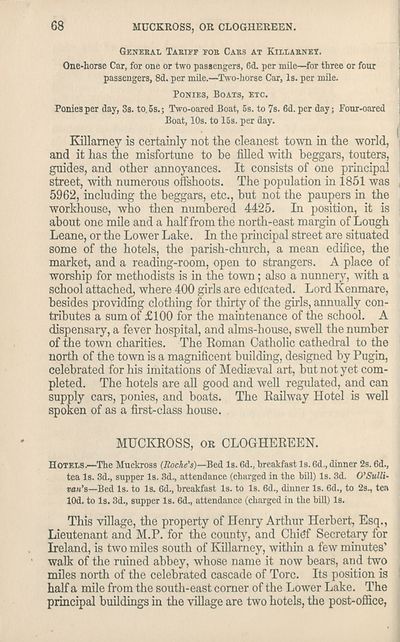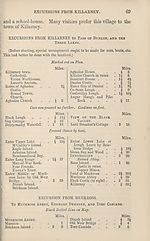Download files
Complete book:
Individual page:
Thumbnail gallery: Grid view | List view

MUCKROSS, OR CLOGHEREEN.
General Tariff foe Cars at Killabnet.
One-horse Car, for one or two passengers, 6& per mile—for three or four
passengers, 8d. per mile.—Two-horse Car, Is. per mile.
Ponies, Boats, etc.
Ponies per day, 3s. to. 5s.; Two-oared Boat, 5s. to 7s. 6d. per day; Four-oared
Boat, 10s. to 15s. per day.
Killamey is certainly not the cleanest town in the world, j
and it has the misfortune to he filled with beggars, touters,
guides, and other annoyances. It consists of one principal j
street, with numerous offshoots. The population in 1851 was
5962, including the beggars, etc., but not the paupers in the
workhouse, who then numbered 4425. In position, it is {
about one mile and a half from the north-east margin of Lough
Leane, or the Lower Lake. In the principal street are situated
some of the hotels, the parish-church, a mean edifice, the
market, and a reading-room, open to strangers. A place of
worship for methodists is in the town; also a nunnery, with a
school attached, where 400 girls are educated. Lord Kenmare,
besides providing clothing for thirty of the girls, annually con¬
tributes a sum of £100 for the maintenance of the school. A
dispensary, a fever hospital, and alms-house, swell the number
of the town charities. The Koman Catholic cathedral to the
north of the town is a magnificent building, designed by Pugin,
celebrated for his imitations of Mediaeval art, but not yet com¬
pleted. The hotels are all good and well regulated, and can
supply cars, ponies, and boats. The Railway Hotel is well
spoken of as a first-class house.
MUCKROSS, or CLOGHEREEN.
Hotels.—The Muckross (ftocie’s)—Bed Is. 6d., breakfast Is. 6d., dinner 2s. 6d.,
tea Is. 8d., supper Is. 3d, attendance (charged in the bill) Is. 3d. O’Sulli-
ran’s—Bed Is. to Is. 6d, breakfast Is. to Is. 6d, dinner Is. 6d, to 2s, tea
lOd. to Is. 3d, supper Is. 6d, attendance (charged in the bill) Is.
This village, the property of Henry Arthur Herbert, Esq.,
Lieutenant and M.P. for the county, and Chief Secretary for
Ireland, is two miles south of Killarney, within a few minutes’
walk of the ruined abbey, whose name it now bears, and two
miles north of the celebrated cascade of Tore. Its position is i
half a mile from the south-east comer of the Lower Lake. The
principal buildings in the village are two hotels, the post-office, ]
General Tariff foe Cars at Killabnet.
One-horse Car, for one or two passengers, 6& per mile—for three or four
passengers, 8d. per mile.—Two-horse Car, Is. per mile.
Ponies, Boats, etc.
Ponies per day, 3s. to. 5s.; Two-oared Boat, 5s. to 7s. 6d. per day; Four-oared
Boat, 10s. to 15s. per day.
Killamey is certainly not the cleanest town in the world, j
and it has the misfortune to he filled with beggars, touters,
guides, and other annoyances. It consists of one principal j
street, with numerous offshoots. The population in 1851 was
5962, including the beggars, etc., but not the paupers in the
workhouse, who then numbered 4425. In position, it is {
about one mile and a half from the north-east margin of Lough
Leane, or the Lower Lake. In the principal street are situated
some of the hotels, the parish-church, a mean edifice, the
market, and a reading-room, open to strangers. A place of
worship for methodists is in the town; also a nunnery, with a
school attached, where 400 girls are educated. Lord Kenmare,
besides providing clothing for thirty of the girls, annually con¬
tributes a sum of £100 for the maintenance of the school. A
dispensary, a fever hospital, and alms-house, swell the number
of the town charities. The Koman Catholic cathedral to the
north of the town is a magnificent building, designed by Pugin,
celebrated for his imitations of Mediaeval art, but not yet com¬
pleted. The hotels are all good and well regulated, and can
supply cars, ponies, and boats. The Railway Hotel is well
spoken of as a first-class house.
MUCKROSS, or CLOGHEREEN.
Hotels.—The Muckross (ftocie’s)—Bed Is. 6d., breakfast Is. 6d., dinner 2s. 6d.,
tea Is. 8d., supper Is. 3d, attendance (charged in the bill) Is. 3d. O’Sulli-
ran’s—Bed Is. to Is. 6d, breakfast Is. to Is. 6d, dinner Is. 6d, to 2s, tea
lOd. to Is. 3d, supper Is. 6d, attendance (charged in the bill) Is.
This village, the property of Henry Arthur Herbert, Esq.,
Lieutenant and M.P. for the county, and Chief Secretary for
Ireland, is two miles south of Killarney, within a few minutes’
walk of the ruined abbey, whose name it now bears, and two
miles north of the celebrated cascade of Tore. Its position is i
half a mile from the south-east comer of the Lower Lake. The
principal buildings in the village are two hotels, the post-office, ]
Set display mode to:
![]() Universal Viewer |
Universal Viewer | ![]() Mirador |
Large image | Transcription
Mirador |
Large image | Transcription
| Antiquarian books of Scotland > Ireland/Irish > Black's guide to Killarney and the south of Ireland > (80) |
|---|
| Permanent URL | https://digital.nls.uk/118861628 |
|---|
| Description | Thousands of printed books from the Antiquarian Books of Scotland collection which dates from 1641 to the 1980s. The collection consists of 14,800 books which were published in Scotland or have a Scottish connection, e.g. through the author, printer or owner. Subjects covered include sport, education, diseases, adventure, occupations, Jacobites, politics and religion. Among the 29 languages represented are English, Gaelic, Italian, French, Russian and Swedish. |
|---|

